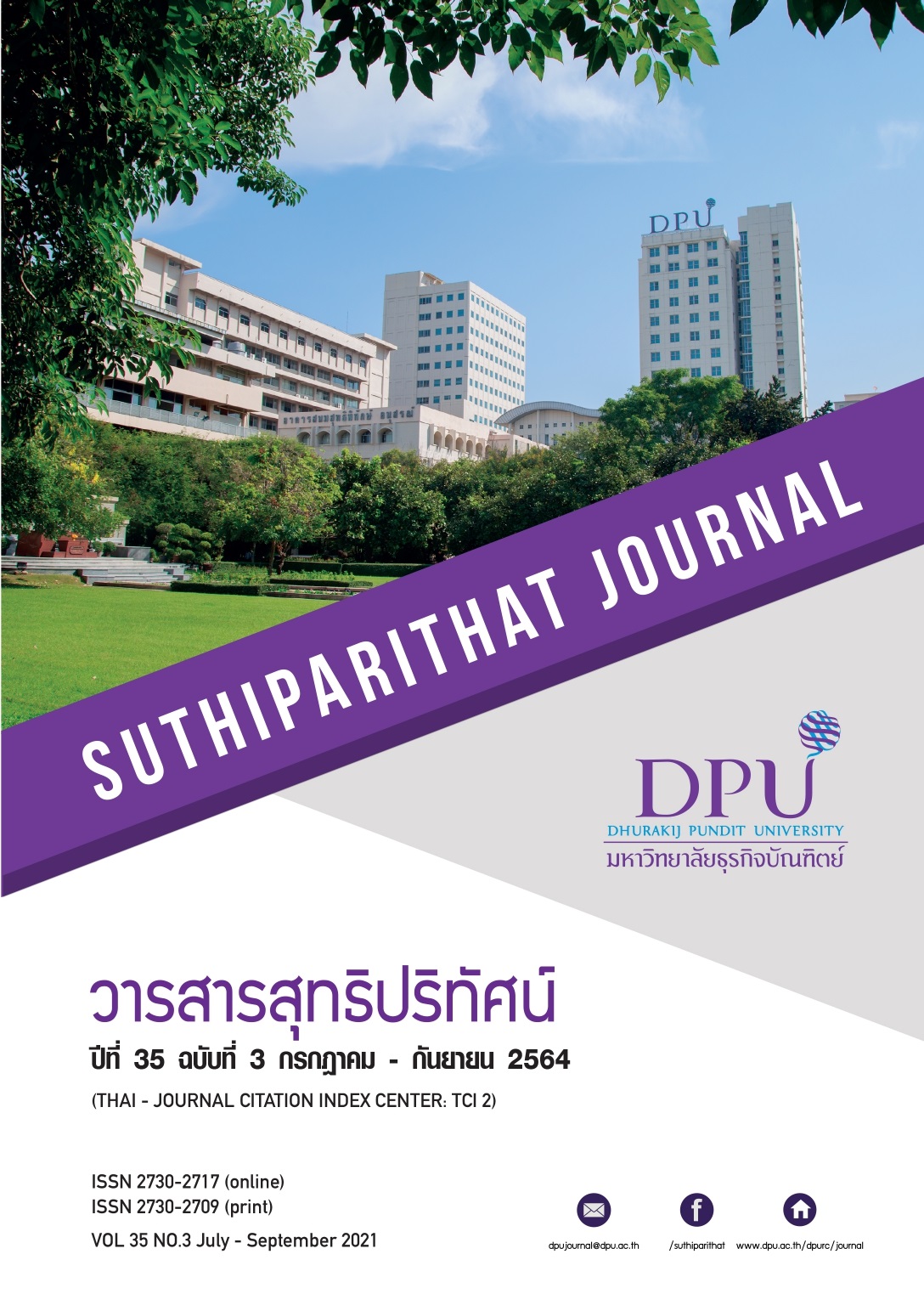วิเคราะห์แนวคิดนโยบายลดความยากจนของประธานาธิบดี สี จิ้นผิง
คำสำคัญ:
ความยากจน, นโยบายลดความยากจน, สีจิ้นผิง, จีนบทคัดย่อ
การศึกษาแนวคิดนโยบายลดความยากจนของประธานาธิบดีสี จิ้นผิง มีวัตถุประสงค์เพื่อ วิเคราะห์สถานการณ์ที่สำคัญที่เกี่ยวข้องกับการพัฒนาเศรษฐกิจจีนในระดับมหาภาค วิเคราะห์ขั้นตอนการดำเนินนโยบายลดความยากจนของประเทศจีน และ วิเคราะห์แนวคิดการดำเนินนโยบายลดความยากจนของประเทศจีน ภายใต้ปธ.สี จิ้นผิง ผลการศึกษาพบว่า เหตุการณ์สำคัญที่ส่งผลต่อการเปลี่ยนแปลงโครงสร้างเศรษฐกิจ สังคม และการลดความยากจน สามารถแบ่งออกเป็น 3 ช่วงเวลาที่สำคัญ ได้แก่ ก่อนการปฏิรูป (1953 - 1977) 2) ช่วงปฏิรูป (1978 - 2000) และหลังการปฏิรูป (2001 -ปัจจุบัน) จีนได้กำหนดขั้นตอนในการลดความยากจน 4 ระดับ ได้แก่ ขั้นตอนที่ 1 เป็นการลดความยากจนจากการปฏิรูประบบระหว่าง ค.ศ. 1979-1985 ขั้นตอนที่ 2 เป็นการลดความยากจนด้วยการพัฒนาระหว่าง ค.ศ.1986-2007 ขึ้นตอนที่ 3 เป็นการใช้ 2 ระบบเพื่อลดความยากจนระหว่าง ค.ศ. 2008-2012 ขั้นตอนที่ 4 เป็นการลดความยากจนอย่างตรงจุด (Targeted Poverty Alleviation) เริ่มจาก ค.ศ. 2013 จนถึงปัจจุบัน แนวความคิดที่ปธ.สี จิ้นผิงเพื่อลดความยากจนประกอบด้วย 4 แนวคิด คือประการแรก การพิสูจน์อย่างตรงจุด (精准识别) ประการที่สอง การช่วยเหลือเพื่อลดความยากจนอย่างตรงจุด (精准帮扶) ประการที่สาม การบริหารจัดการอย่างตรงจุด (精准管理) และประการสุดท้ายการตรวจสอบอย่างตรงจุด (精准考核) ผลที่เกิดขึ้นทำให้จีนลดจำนวนคนจีนได้อย่างมีประสิทธิภาพ โดยจำนวนคนจนลดลงจาก 405 ล้านคนในปี 2002 เหลือ 7.2 ล้านคนในปี 2016 หรือลดลงร้อยละ 98.2 ในระยะเวลาเพียง 14 ปี
เอกสารอ้างอิง
จุลชีพ ชินวรรโณ. (2547). ความสัมพันธ์ระหว่างประเทศ แนวคิด ทฤษฎี และกรณีศึกษา. กรุงเทพฯ: คณะรัฐศาสตร์ มหาวิทยาลัยธรรมศาสตร์.
ไชยสิทธิ์ ตันตยกุล. (2562). แนวคิดทางยุทธศาสตร์ของจีนภายใต้การนำของประธานาธิบดี สี จิ้นผิง (ตอนที่ 1 เป้าหมายและทิศทาง). สืบค้นจาก http://www.vijaichina.com/articles/1447
ปิยะภพ มะหะมัด. (2559). คุณูปการของเติ้ง เสี่ยวผิง ที่มีต่อการสร้างสรรค์จีนให้ทันสมัย. วารสารเศรษฐศาสตร์การเมืองบูรพา, 4(1), 113-129.
มนัสชัย จึงตระกูล. (2553). ถอดเกร็ดเศรษฐกิจมังกร: พัฒนาการของการเปลี่ยนแปลงโครงสร้างเศรษฐกิจและนโยบายของจีน. แว่นขยายเศรษฐกิจ-สายนโยบายการเงิน,18.
ยศ สันตสมบัติ. (2557). มังกรหลากสี : การขยายดินแดนกับพันธกิจการสร้างอารยธรรมในอุษาคเนย์. กรุงเทพฯ : สํานักงานคณะกรรมการส่งเสริมวิทยาศาสตร์ วิจัยและนวัตกรรม.
ศูนย์วิจัยกสิกรไทย. (2551). ทิศทางเศรษฐกิจจีนหลังโอลิมปิก 2008: ปรับโครงสร้างเพื่อเติบโตอย่างสมดุล. กระแสทรรศน์. สืบค้นจาก https://www.kasikornresearch.com/th/analysis/k-econ/economy/Pages/16004.aspx
สำนักงานปลัดกระทรวงพาณิชย์. สำนักบริหารกิจการต่างประเทศ. (2554). 10 ปีของจีนในฐานะสมาชิกองค์การการค้าโลก (WTO). สืบค้นจาก https://www.moc.go.th/images/Agencies_Information/Trade_Situation/Commercial_Beijing/18.pdf,
อาร์ม ตั้งนิรันดร์. (2561). China 5.0 สีจิ้นผิง เศรษฐกิจจีนยุคใหม่ และแผนการใหญ่ AI. บุ๊คสเคป.
อักษรศรี พานิชสาส์น. (2562). The rise of CHINA จีน คิดใหญ่ มองไกล. กรุงเทพฯ: ซีเอ็ดยูเคชั่น.
Bardhan, P. (2007). Poverty and inequality in China and India: Elusive link with globalisation. Economic and Political Weekly, 42(38), 3849-3852.
Admin. (2551). จากแบรนด์จีนสู่แบรนด์โลก ในโอลิมปิก 2008. สืบค้นจาก https://positioningmag.com/11143
Chow, N. (2015). My experience researching poverty over the past 35 years. China Review, 15(2), 9-21. Retrieved September 1, 2020
De Janvry, A., & Sadoulet, E. (2010). Agricultural growth and poverty reduction: Additional evidence. The World Bank Research Observer, 25(1), 1-20.
Fan, S., Zhang, L., & Zhang, X. (2004). Reforms, investment, and poverty in rural China. Economic Development and Cultural Change, 52(2), 395-421. doi:10.1086/380593
General Office of the Communist Party of China, & General Office of the State Council of the People's Republic of China. (2016). แนวทางการสร้างกลไกการพ้นจากความยากจน. สืบค้น 26 สิงหาคม 2563, จาก http://www.gov.cn/zhengce/2016-04/28/content_5068878.htm
Geoff, C. (2019, July 22). It’s China’s world. Fortune Magazine. Retrieved from https://fortune.com/longform/fortune-global-500-china-companies/
Guo, J., & Weimin, W. (2018). Policy analysis on the Xi Jinping’s new era and China’s Strategy. MFU Connexion, 7(2), 198.
MGR Online. (2551, 27 มกราคม). จีนมั่นใจเศรษฐกิจหลังโอลิมปิกรุ่งโรจน์. MGR online. สืบค้นจาก https://mgronline.com/china/detail/9510000007910
National Bureau of Statistics. (2020). Statistical database. Retrieved July 1, 2020, from https://data.stats.gov.cn/english/
Ravallion, M. (2011). A comparative perspective on poverty reduction in Brazil, China, and India. The World Bank Research Observer, 26(1), 71-104. Retrieved September 1, 2020, from http://www.jstor.org/stable/41261423
Rostow, W. (1959). The stages of economic growth. Economic History Review, 12(1), 1–16.
Shen, J., Han, X., Hou, Y., Wu, J., & Wen, Y. (2015). The relationship between marine biodiversity conservation and poverty alleviation in the strategies of rural development in China. Journal of Coastal Research, 781-785.
Strauss, D. (2019). These are the 14 largest Chinese companies. Business Insider. Retrieved from https://markets.businessinsider.com/news/stocks/14-biggest-chinese-companies-based-on-market-cap-2019-7-1028377989#
Tak-chuen, L. (2000). The politics of poverty eradication in rural China. China Review, 509-527. Retrieved September 1, 2020, from https://www.jstor.org/stable/23453381
The State Council Leading Group Office of Poverty Alleviation and Development. (2013). แผนการดำเนินการสร้างกลไกทำงานลดความยากจนอย่างตรงจุด. สืบค้น 26 สิงหาคม 2563, จาก http://www.cpad.gov.cn/art/2014/5/26/art_50_23765.html
The State Council Leading Group Office of Poverty Alleviation and Development. (2014). แผนการสร้างบัตรบันทึกประวัติเพื่อพัฒนาและลดความยากจน. สืบค้น 26 สิงหาคม 2563, จาก http://www.cpad.gov.cn/art/2014/4/11/art_27_22097.html
Thorat, S., & Fan, S. (2007). Public investment and poverty reduction: Lessons from China and India. Economic and Political Weekly, 42(8), 704-710. Retrieved September 1, 2020
Wang, C., & Liu, J. X. (2018). The evolution of Chinese anti-poverty work over the past 40 years: An quantitative analysis based on China’s anti-poverty policies, 1-17.
World Bank. (2020). Poverty and Inequality databank. Retrieved from https://data.worldbank.org/
Yao, S. (2000). Economic development and poverty reduction in China over 20 years of reforms. Economic Development and Cultural Change, 48(3), 447-474. doi:10.1086/452606
Yao, S. J., & Wang, J. F. (2019). เส้นทางการพัฒนาเศรษฐกิจและลดความยากจนของจีนใหม่ใน ปีที่ 70 ผ่านมา. Journal of Zhongnan University of Economics and Law, 237(6), 16-23.
Yu, J. (2013). Multidimensional poverty in China: Findings based on the CHNS. Social Indicators Research, 112(2), 315-336. Retrieved September 1, 2020, from http://www.jstor.org/stable/24719187
Zheng, X. Y. (2019). รายงานการประเมินผลการใช้นโยบายลดความยากจนอย่างตรงจุด National Academy of Development and Strategy, Renmin University of China. สืบค้น 28 สิงหาคม 2563, จาก http://ae.ruc.edu.cn/docs/2019-08/4632c8c5c4154e84ae03a432bc5e981a.pdf
ดาวน์โหลด
เผยแพร่แล้ว
รูปแบบการอ้างอิง
ฉบับ
ประเภทบทความ
สัญญาอนุญาต
เนื้อหาและข้อมูลในบทความที่ลงตีพิมพ์ในวารสารสุทธิปริทัศน์ ถือเป็นข้อคิดเห็นและความรับผิดชอบของผู้เขียนบทความโดยตรงซึ่งกองบรรณาธิการวารสาร ไม่จำเป็นต้องเห็นด้วย หรือร่วมรับผิดชอบใด ๆ
บทความ ข้อมูล เนื้อหา รูปภาพ ฯลฯ ที่ได้รับการตีพิมพ์ในวารสารสุทธิปริทัศน์ ถือเป็นลิขสิทธิ์ของวารสารสุทธิปริทัศน์หากบุคคลหรือหน่วยงานใดต้องการนำทั้งหมดหรือส่วนหนึ่งส่วนใดไปเผยแพร่ต่อหรือเพื่อกระทำการใด ๆ จะต้องได้รับอนุญาตเป็นลายลักษณ์อักษรจากวารสารสุทธิปริทัศน์ก่อนเท่านั้น







